Home › Whats your project?
WHAT'S YOUR PROJECT?
Tell us what your project is and we will deliver a full audio report with a setup recommendation!
With our Audio Analysis Service, you as a partner have the opportunity to receive a scientifically based audio report tailored for your Artcoustic projects.
Our comprehensive service includes detailed insights such as heat maps, frequency response curves, and recommendations for optimal subwoofer placement.
In this section, we also take you through guidelines essential for designing cutting-edge home cinemas, with a particular focus on Dolby Atmos technology. Our “Artcoustic Cinema Design Essentials” equips you with the information needed to elevate your audio projects to new heights.
Explore the wealth of resources available to make informed decisions and deliver unparalleled audio experiences to your clients. We’re committed to providing you with the expertise and support necessary to excel in the ever-evolving world of audio technology.
THE ARTCOUSTIC AUDIO ANALYSIS SERVICE
The Artcoustic Audio Analysis Service has been designed to ensure predictable, consistent results on every single project. Much like a good lighting design, or a WiFi coverage map, it is highly beneficial to predict the results before the project is installed.
We want to help create trust and credibility for your client and confidence for the installation, as well as eliminating expensive mistakes at the pre-quotation stage. We will offer complimentary acoustic reporting for Artcoustic projects only, with comprehensive support in areas such as:
- Pre-quotation of acoustic room analysis, including DIN standard, SPL noise mapping
- Subwoofer placement and phase alignment analysis
- Product suggestions and configuration
- Room acoustic treatment
Whether you’re looking to specify for commercial cinema rooms or residential audio systems, we’ve got you covered.
Projects we do analyses for include, but are not limited to:
- Residential Cinema
- Residential 2-channel Audio Systems
- Outdoor Audio Systems
- Commercial Audio Systems
- Commercial Cinemas*
*For commercial cinemas we include the Dolby DARDT (Dolby Audio Design Tool) to make sure everything is aligned within the strict guidelines for Dolby ‘commercial cinema’ approval.
Requirements
Below you can find a list of things we will need, in order to help you with your next quote.
- An easy-to-read floor plan, including overall dimensions and ceiling height
- Expected reference sound pressure level
- Preferred Artcoustic models specified for the job
- Ideal position of speakers, relative to actual space and mounting possibilities
- For cinemas, screen type and screen size, preferably included on the floor plan
- Seating, rows, and elevation
- For commercial installations, DJ, live bands etc. – crest factor and headroom measurements
Our audio analysis report turnaround time would normally be within 2 working days and will only be available for fully quoted Artcoustic cinemas. We do not offer this service for any other speaker brands.
CINEMA DESIGN ESSENTIALS
The “Artcoustic Cinema Design Essentials” is designed to take you through some of the key processes to help design your dream cinema.
THE ROOM
Whilst every room is different, there are some key elements that make up the essence of succesful cinema design.
- Seating position: Both screen size and speaker specification are determined by where you sit and the number of rows. Take the measurement to first seating position or, if tiered, measure to between seating to ensure best experience for all seats.
- Boundaries: Dolby recommend 0.5m (min) up to 1.5m boundary to side and rear walls. A gap of 750mm between seats to ensure a comfortable experience.
- Plinths: Required for 2nd tier and subsequent rows, a min. 300mm height is required. Remember to check ceiling height to ensure clearance.
- Access: Can doorways be moved, re-hung or re-positioned to allow for best access and build of room structure? Windows may require acoustic treatment or blocked out altogether.
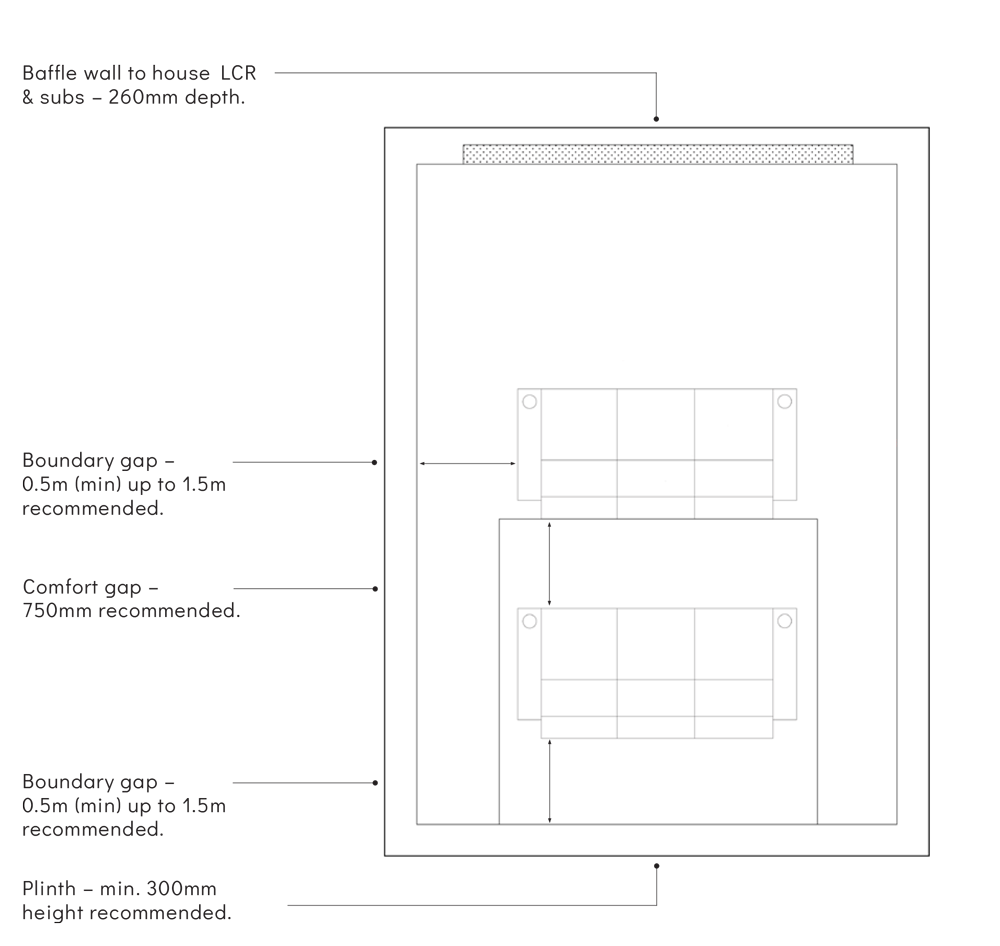
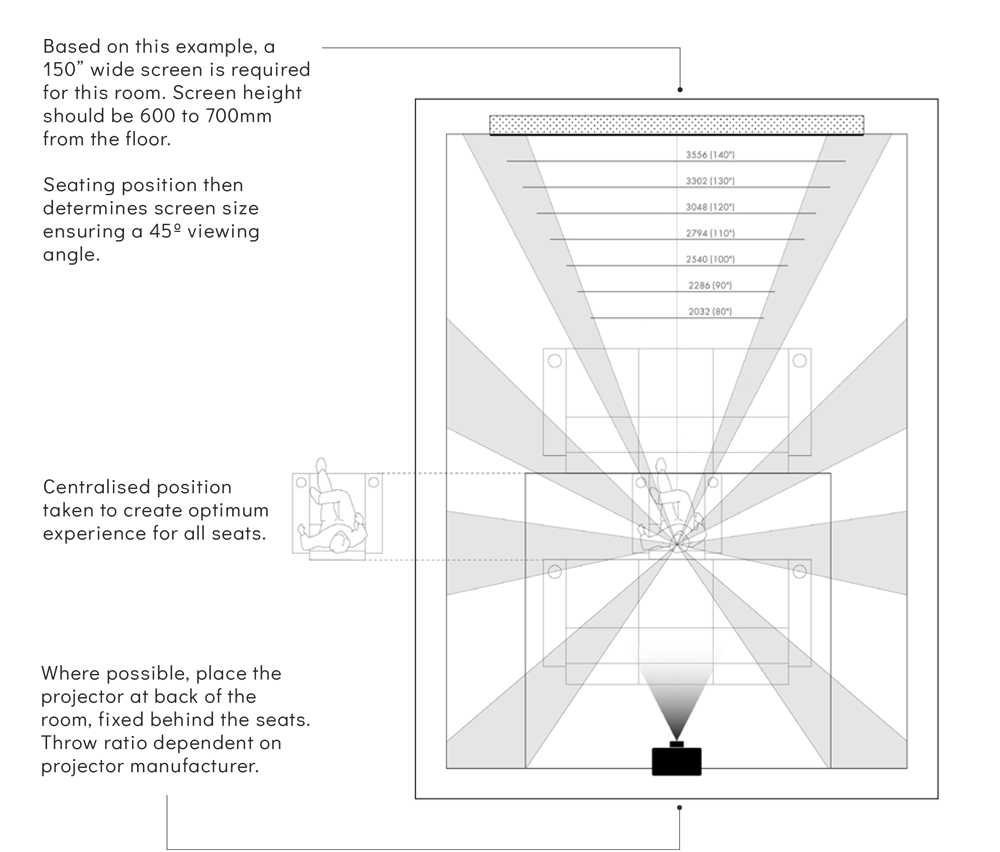
THE Screen
The screen needs to deliver scale and a cinematic experience that keeps every seat happy.
- The position of the seating determines the size of the screen.
- Screen height should be 600 to 700mm from floor dependent on ceiling and screen height. Ideal viewing angle is 45o.
- Projector – 25 to 40 lamberts is the target output , depending on HDR requirements. The further back you place the projector, the more lumens you also need.
- Remember – a change in screen position height may require an increase in size to any plinths for tiered seats. Moving the seating positions will require a change to the screen size.
- An acoustically transparent screen allows for the speakers to go behind the screen.
THE speakers
Immersive, dynamic and subtle, sound creates the environment beyond the screen.
- Look for high sensitivity speakers that demand less power, and provide the dynamic range required (measured at dB @ 1 watt).
- The seating position determines both the output required and speaker placement.
- Dolby give us all the rules we need for speaker specification and placement.
- SPL is a measure of output, ie can the speakers play loud enough to create the levels of excitement and energy for a cinematic experience, (normally measured at ‘long term, half space’).
- Dispersion is key to the efficiency of the speaker, much like the beam from a torch, the narrower the beam, the more focused it is.
- The correct dispersion ensures the best performance for every seat in the room, whilst reducing room interference.
Dolby provide the guidelines as to speaker positions, based on how the human ear receives sound →
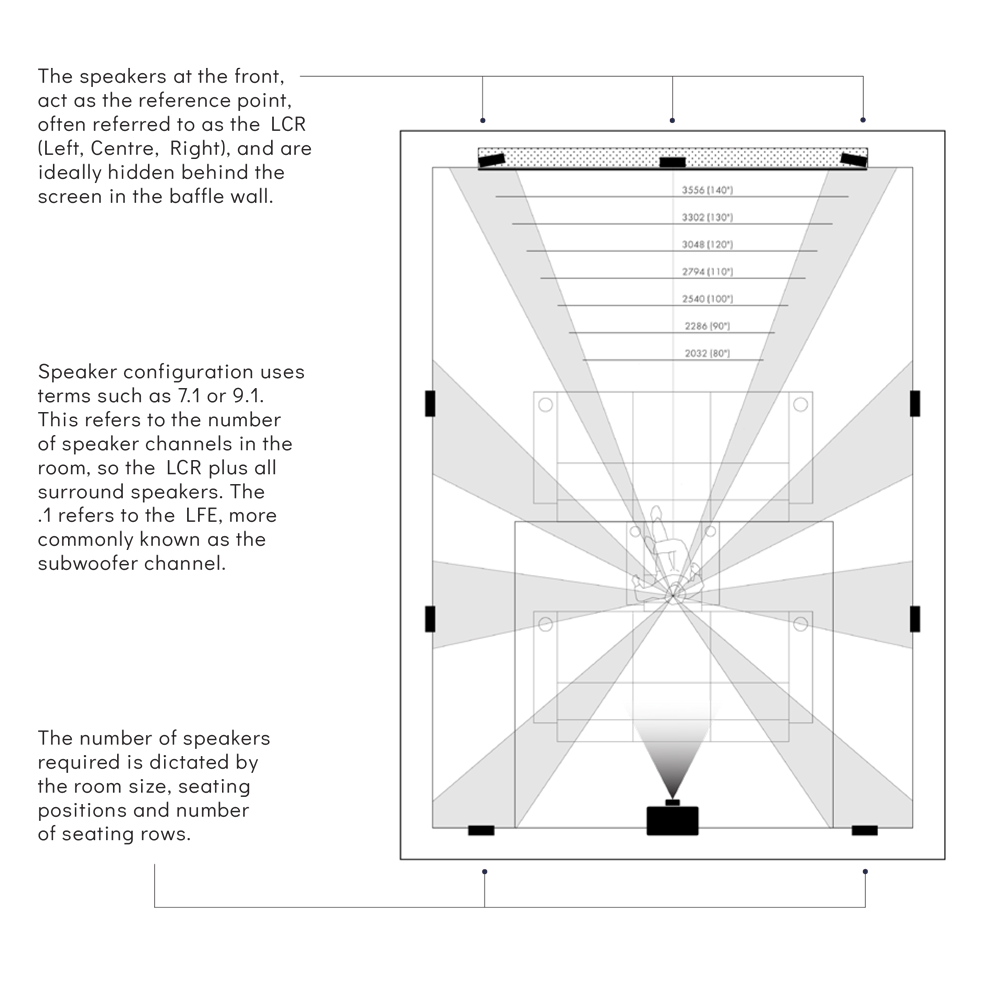
Dynamic range
We understand dynamic range in picture, audio is no different. Our starting point again is Dolby who state that the reference level we need to achieve is 105dB. This figure is based on the calculation of 85dB (talking volume) plus 20dB for detail, ie the peaks, from loud to quiet, that each film demands.
Essentially dynamic range is the difference between the highest and the lowest peaks – the broader the range the more detail you will hear.
Detail enriches the film experience and elevates it from bland to extraordinary.
It is always important when designing your system to incorporate headroom to allow for EQ, low distortion levels and to retain the dynamic range.
IMPORTANT: A speaker with a low sensitivity and large power requirement, will most probably deliver a poor dynamic range = less detail. Additionally, a lower SPL means it will not achieve the target output, impacting the quality of the audio experience.
In this shot from ‘The Godfather’ movie, we can see both images are vastly different. The low dynamic image has less detail and has lost its’ clarity, and we can no longer see the facial features, suit, tie or hat with the same level of definition.
Audio works on exactly the same principal – it allows the tonal variations therein, to operate within a larger ‘range’ to give you the audio detail for maximum film enjoyment.

High Sensitivity Speaker & low power requirement = High Dynamic Range

Low Sensitivity Speaker & high power requirement = Low Dynamic Range
ATMOS
What is Dolby Atmos and why is it important?
Dolby Atmos is an advanced audio technology that allows sound engineers to create a more immersive and realistic audio experience. It adds height and dimension to traditional surround sound systems by introducing overhead speakers and advanced audio processing algorithms.
Instead of simply placing sounds around the listener, Dolby Atmos allows for specific three- dimensional locations, creating a more realistic and enveloping soundscape. This technology also allows for individual sound objects to be moved around in real time, providing a more dynamic and flexible audio experience.
Dolby Atmos is important because it significantly enhances the quality and realism of audio content, providing a more engaging and immersive experience for the listener. It allows viewers and listeners to experience sound as if they are truly in the middle of
the action, which can greatly enhance the emotional impact of movies, music, and other content.
Audio separation refers to the distance between ALL speakers, if they are too far apart then there is a loss of cohesion. Too close together, then the speakers will act in mono.
Typically, Atmos speakers are placed 35o horizontally from the centre position, and 45o vertically.
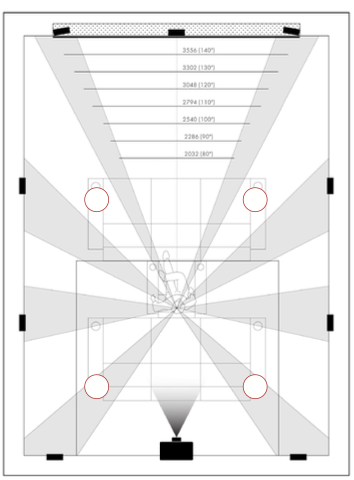
subwoofers
Sub placement is an important factor in creating an integrated and dynamic audio experience.
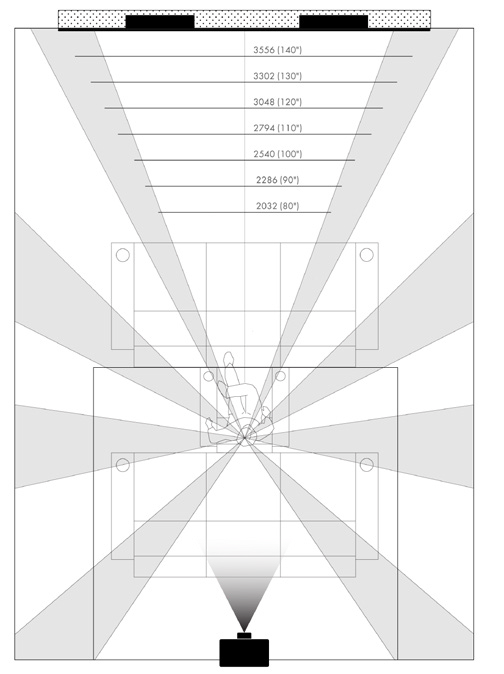
However, rooms interact with bass frequencies, often known as ‘room modes’, and can drastically alter the frequencies that you actually hear. In some cases this can mean no bass at all.
Each room is different and so it’s critical to utilise independent software at the design stage to help mitigate issues at installation’. An example is shown here, where additonal subs at the back of the room result in a far better experience.
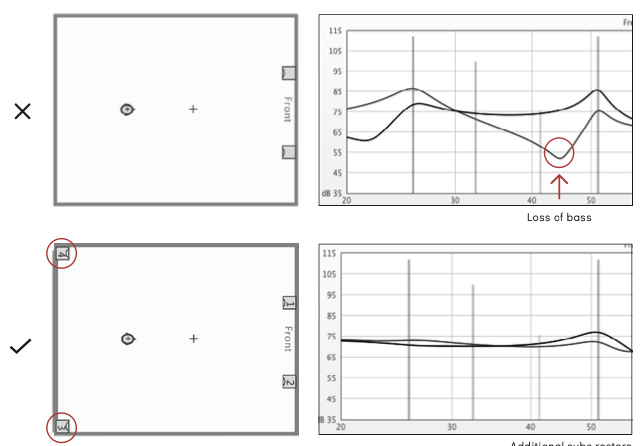
Additional subs restore the bass frequency
Dispersion
Much like the beam of a torch, the audio ‘beam’ is hugely important. Referred to as dispersion, the wider the beam, the less concentrated the audio, which can cause unwanted reflection and loss of SPL.
In a fixed seating position, a narrower, more focused vertical beam is far more effective.
Illustration with a 30W light bulb

30W wide dispersion typical HI-FI design
Illustration with a ceilling lamp

Controlled dispersion typical horn design
Heatmaps
Ordinarily we cannot ‘see’ the audio, however, with our audio analysis report we can remove any guesswork.
Prepared specifically for your own room, these provide certainty, before installation, and ensure that we have consistency of audio distribution across the room and to all seating positions.
Once the integrity of the technical design is complete we can now concentrate on the aesthetic choices to deliver your dream room.
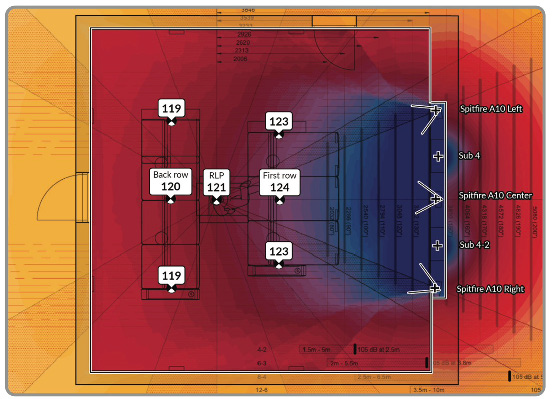
Media room
WHAT’S THE DIFFERENCE?
Media rooms are treated with exactly the same integrity of design, so therefore the process should adhere to the same common principles used for cinema. However, there is one key difference; the target output.
Where Dolby recommend 105dB for cinema, this would seem unnecessary for a room, such as a lounge, given the nature of use compared with a dedicated cinema room.
Here, we simply change our target to 99dB, which at 6dB less is actually half the volume. This is a good compromise as this will still deliver excellent levels of dynamic range and retain the overall audio impact and resonance.
We still apply the same design construction principles, for example:
• What is the size of the room?
• What is the seating distance?
• How many channels are possible to integrate with the room aesthetic?
• Do we have space for Atmos channels?
• Where is the best location for the subwoofer(s) based on room response?
When designing your media room, look for a speaker brand that has a broad and consistent range. This allows your room to be designed correctly, with no over-specification or over-spend, ensuring the right speaker, for the right reason.
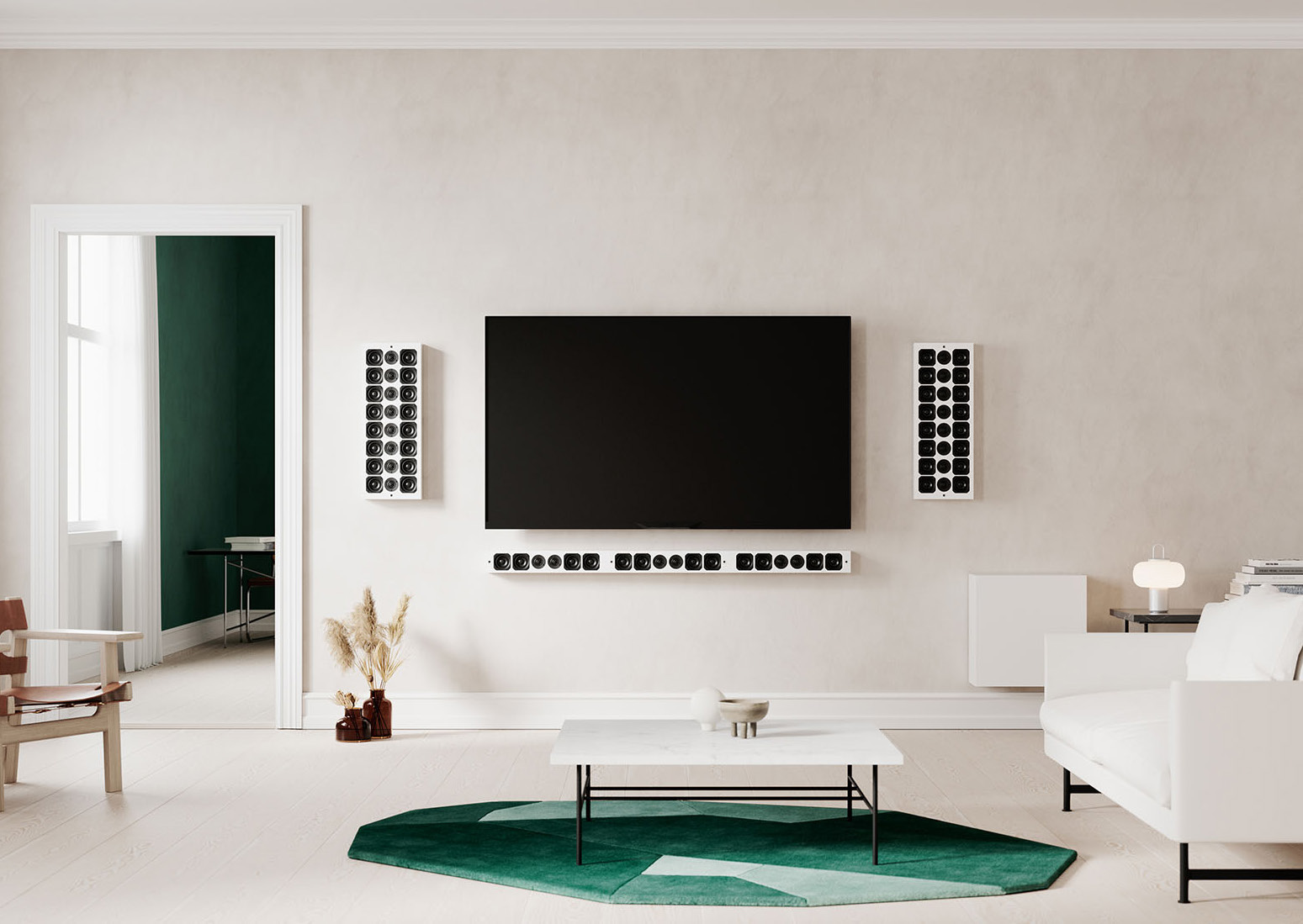
Good practice is to always request a technical design and heat maps to show correct system design.
the importance of sensitivity
When selecting your speaker, check the sensitivity available for the given distance.
IMPORTANT: dB levels are logarithmic, not linear, therefore 99dB is HALF the volume of 105dB. Also check dispersion & power handling/required.
Remember that the level of sensitivity determines the amount of power required and the subsequent dynamic range.
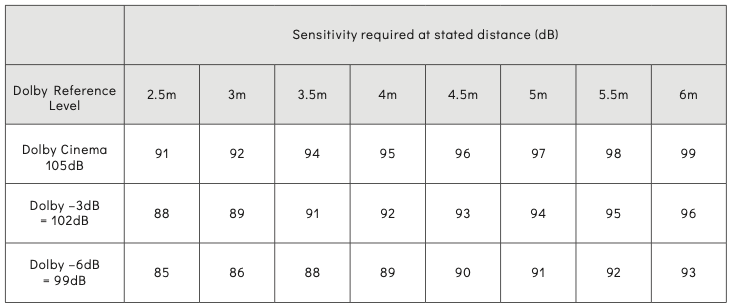
Calculations based on 100w power, low acoustic space reflectivity/reverb.
Speaker check
EVOLVE SERIES
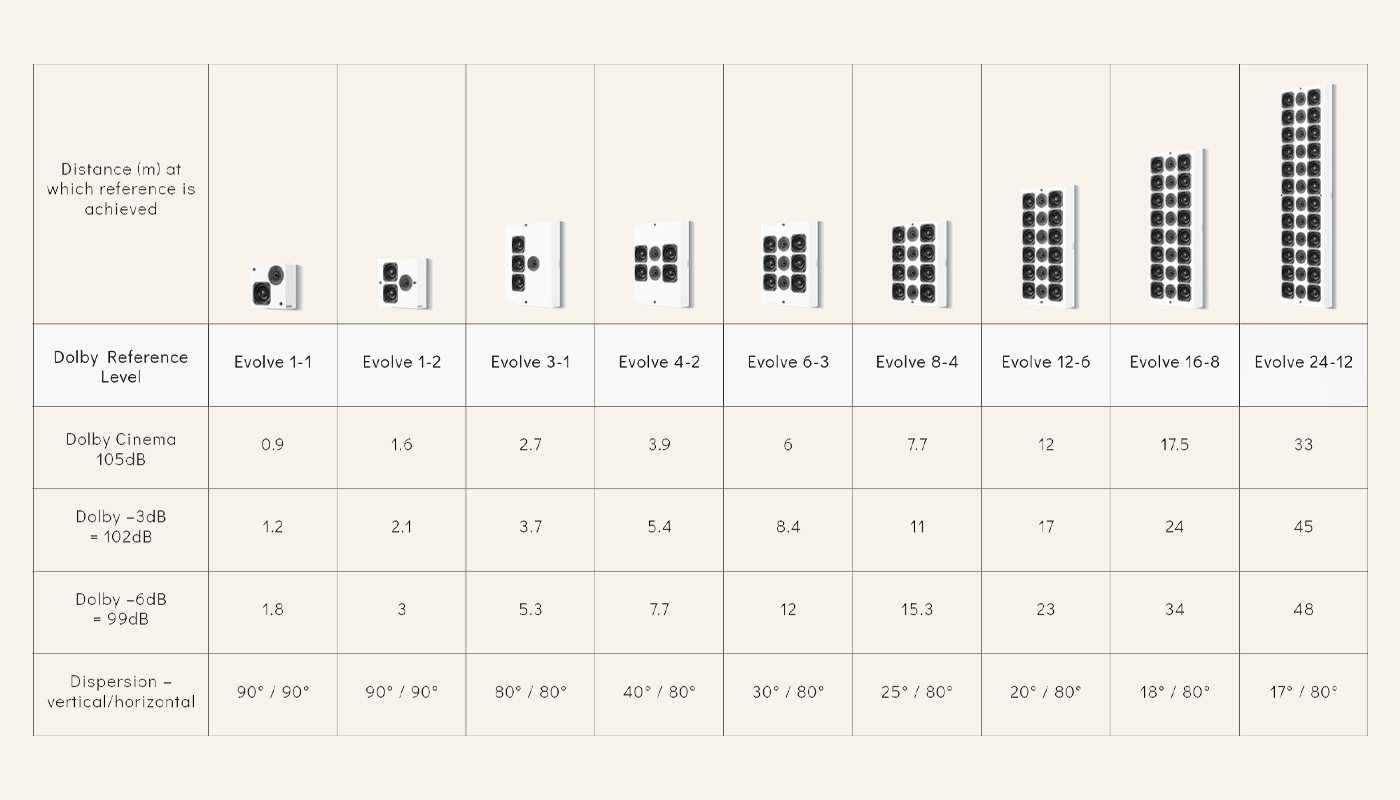
Speaker check
SPITFIRE SERIES
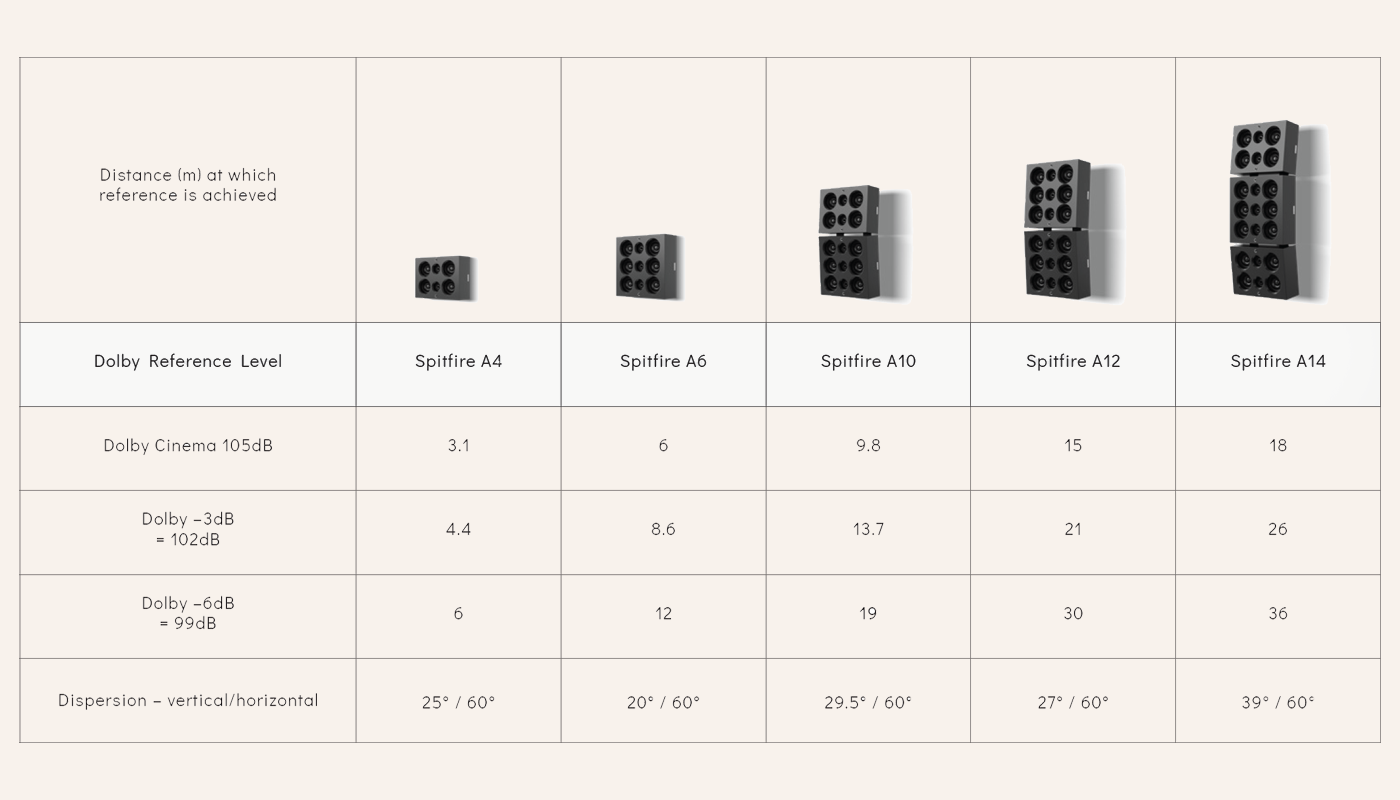
Why is sound so important in cinema?
Sound is an essential component of cinema that adds depth, emotion and realism to the audiovisual experience. Without sound, a movie would lose much of its impact and emotional resonance.
First and foremost, sound enhances the storytelling of a film by providing an additional layer of information to the viewer. Dialogue, sound effects, and music all work together to create a complete audiovisual narrative. Through sound, viewers can hear the emotions and thoughts of the characters, feel the impact of explosions or crashes, and be immersed in the movie’s environment.
Sound also helps to establish the mood and tone of a film. The score or soundtrack can create tension, excitement, or melancholy, enhancing the viewer’s emotional response to the film. Subtlety of sound effects such as distant footsteps or a solitary ticking clock, can build suspense and add to the overall atmosphere of the movie.
Moreover, sound can be used to guide the viewer’s attention and focus. By manipulating the sound mix, filmmakers can emphasize or de-emphasize certain elements of the film, directing the viewer’s attention to the most important aspects of the scene.
As George Lucas once said, “sound is 50% of the movie-going experience.” Therefore, it is essential to the overall impact of cinema, creating emotional context and texture that puts us, the listener, at the heart of the action, providing truth and realism to the audiovisual experience.
WHAT ARE THE KEY ELEMENTS FOR SOUND IN CINEMA?
There are key factors that contribute to enthralling sound in cinema, and enhance the storytelling:
Clarity: The sound should be clear and easy to understand. This includes dialogue, sound effects, and music. If the sound is muddled or difficult to hear, it can detract from the viewer’s experience. It is important, then, to look for a speaker that is capable of guided directivity with excellent response curves and minimal acoustic loss over distance.
Dynamic Range: A good cinematic sound system should be capable of producing a wide range of sound, from the quietest whispers to the loudest explosions. This helps to create a sense of depth and realism in the sound. Speakers with a high sensitivity rating and a low power requirement ensure the broadest dynamic range.
Surround Sound: Surround sound technology allows the viewer to hear sound from all around the theater, creating a more immersive experience. A good cinema sound system should have a minimum of five speakers and at least 1 subwoofer, and should be properly calibrated for optimal sound quality. The number of seats, size of the room and ceiling height all dictate the required number of speaker channels.
Atmosphere: The sound should help to create a sense of atmosphere and mood. This can be achieved through the use of ambient sounds, music, and sound effects. Dolby Atmos channels help create this atmosphere, so wherever possible look to include these as part of your audio design to create the most cohesive, integrated and real audio experience possible.
Overall, outstanding sound in cinema requires a high-quality sound system, that brings to life the sound design, and skill of the film sound engineers.
When these elements are combined effectively, the result is an immersive and unforgettable movie-watching experience.
WHY ARTCOUSTIC
Audio is made up of the objective and the subjective. There are the parts we can measure, the undeniable facts, and then those which are opinion, or based on a preference.
In cinema design we need to ensure that we have incorporated 4 key essentials:
1. Speakers that play at the required target output
2. The dynamic range to deliver the source material
3. The correct dispersion for the listening distance and location
4. The correct phase and sensitivity with power to match
Get all of that right and your audio experience will sound amazing.
At Artcoustic, we design our speaker range based on all of these principles, solely focused on achieving only the very best audio outcomes, whatever the size of your project.
Artcoustic have been designing speakers since 1998. Our comprehensive range spans speaker systems for private homes and commercial spaces, offering bespoke solutions that are flexible and adaptable to deliver the ultimate sound experience.
Artcoustic’s approach to quality audio is driven by integrity and credibility. We don’t take the normal upgrade option of baffling audio terms to add special magic to the next model up in the range. All Artcoustic speakers are built and designed with the same DNA, the same honesty and integrity in every model, giving a predictable, measurable result every time.
Our in-house design service helps support our trained installer network to design and explain why a certain model in the range is appropriate for the application. This is a scientific, mathematical, and independent approach which means when we recommend a design for any audio application, we have the data to back it up, and the knowledge to explain it, simply.